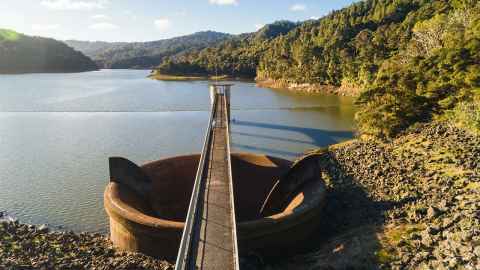Study confirms PFAS in NZ urban water
14 January 2022
The presence of PFAS in New Zealand wastewaters, coastal waters, and surface waters has been confirmed by University of Auckland researchers.

This is not surprising, they say, as PFAS (Per- and Polyfluoroalkyl Substances) are found everywhere on the planet. But how they have got into New Zealand’s water system specifically is unknown.
The chemicals, which have been manufactured since the 1930s, are used in products such as non-stick pans, water-repellent fabrics, fast food wrappers, stain-resistant fabric coatings, cleaning products, cosmetics, paints and other household items including carpets and furniture.
They provide a bond between carbon and fluorine, one of the strongest in nature, which means they are difficult to break down, hence the name "forever chemicals".
“We have no known PFAS manufacturing industry in New Zealand,” says Dr Lokesh Padhye, a research team member from the university’s Faculty of Engineering. “So we can only assume they come from imported products and historical use.”
Finding out which products, and how chemicals from these products, end up in the water cycle is the next urgent step, says Dr Padhye.
The study found PFAS concentrations in the areas monitored were low in comparison to those reported overseas. But researcher Dr Melanie Kah, from the Faculty of Science, points out it is not yet understood what level of PFAS is safe.
“There is still so much that is unknown,” says Dr Kah. “Guidelines for safe levels are not available for all PFAS, and the guidelines we do have are being revised constantly as more ecotoxicological and health data becomes available.”
The study is the first in the country to monitor PFAS in domestic urban water cycles and was published this week in the Journal of Hazardous Materials. It involved monitoring samples from two urban wastewater treatment plants, from water bodies receiving the treated wastewater and from a drinking water treatment plant. Researchers detected 20 out of 38 monitored PFAS.
Coastal samples and surface water samples were also taken at set distances from the wastewater treatment plants.
“Our monitoring shows wastewater treatment significantly reduces the concentration of PFAS,” says Dr Kah.
“However, as in overseas experience, not all PFAS are removed which means some are released into the environment.”
Says Dr Padhye: “Our study has confirmed that PFAS are present even in New Zealand where we have no PFAS-producing industry. If we can identify where they are coming from, and develop effective technologies to remove them, we can potentially reduce daily exposure to PFAS, protecting ourselves and our environment.”
The research team is currently studying advanced treatments to remove these compounds from water and is also about to launch a citizen-science project to assess people’s exposure to contaminants in their home, including PFAS.
Media queries
Alison Sims | Media adviser
DDI 09 923 4953
Mob 021 249 0089
Email alison.sims@auckland.ac.nz